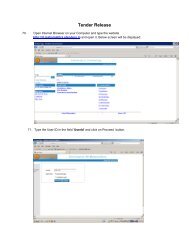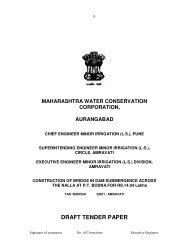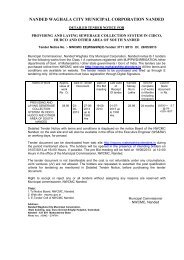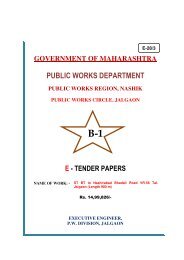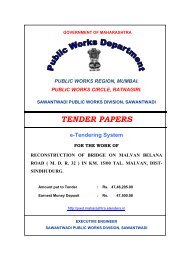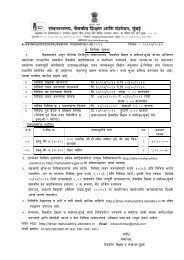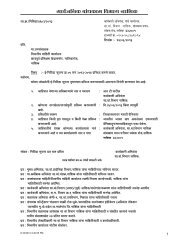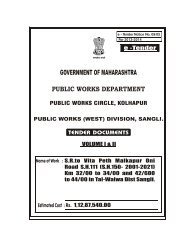B-1 AGREEMENT System Generated e-Tender No ... - e-Tendering
B-1 AGREEMENT System Generated e-Tender No ... - e-Tendering
B-1 AGREEMENT System Generated e-Tender No ... - e-Tendering
You also want an ePaper? Increase the reach of your titles
YUMPU automatically turns print PDFs into web optimized ePapers that Google loves.
93 Dy. Executive Engineer<br />
6. PROCEDURE FOR HANDLING, STACKING & TRANSPORTING OF COATED<br />
REINFORCING BARS<br />
The durability of the coated rebars is related to the coating quality. The more damage is to the<br />
coating, it is more prone to corrosion. Good jobs site practices can minimise the coating<br />
damage. For this reason, standards, such as ASTM, JSCE, NACE (USA) have laid down<br />
specific procedures for stacking and transporting coated bars. Some important guidelines are<br />
referred here.<br />
6.1 Stacking:<br />
6.1 a) It is preferable to store the coated bars on buffer material placed at suitable intervals instead<br />
of placing them directly on the ground.<br />
6.1 b) It is nor desirable to store coated bars by piling them on top of one another. If they are to be<br />
stored by piling, buffer materials such as wood, rubber, jute sack etc. , should be used to<br />
separate the layers. However, the number of layers allowed shall be limited to a maximum of<br />
five.<br />
6.1 c) The coated rods shall be stored in an enclosed yard.<br />
6.1 d) If any damage had accured during stacking it should be repaired immediately before any<br />
rusting could occur by using the same coating formulation.<br />
6.2 Handling and Transporting<br />
6.2.a) The coated bars shall be securely bound together using a buffer material (Padding) and it<br />
is desirable that the best bars shall be supplied with some canvas cover.<br />
6.2.b) When loading and unloading bundles of coated bars, it shall be preferable to lift them, with a<br />
strong back, spreader bar multiple supports etc. To avoid extreme bending, nylon slings at 2<br />
or 3 points shall be used.<br />
7. SPECIFICATIONS FOR PATCH REPAIRING OF COATING DAMAGES.<br />
7.1 Coating repair is required when peeling off and other damages accur during fabrication or<br />
handling.<br />
7.2 The patch repair shall be done at site using the same coating material as per the<br />
manufacturer’s recommendations.<br />
7.3 It is essential to ensure a minimum coating thickness of 150 microns at all the repaired<br />
portions before embedding in concrete.<br />
REFERENCE DOCUMENTS.<br />
1. ASTM G8 -90 Standard test methods for cathodic disbonding of pipeline coatings (Method A)<br />
2. ASTM G20-88 Standard test method for chemical resistance of pipeline coating.<br />
3. ASTM G12-83 Standard test method for non-destructive measurement of film thickness of<br />
pipeline coating on steel.<br />
4. ASTM D-4060-90 Standard test method for abrasion resistance of organic coating by the<br />
Taber Abraser.<br />
5. ASTM -G14-88 Standard test method for impact resistance of pipeline coating (fallingweight<br />
test)<br />
6. BIS-2770 Part-I-1967 Method of testing bond in Reinforced Concrete part 1 Pullout Test<br />
(1967)<br />
7. SSPC-SP 10-NACE <strong>No</strong>.2 1994 Near White Blast Cleaning.<br />
8. SSPC-VIS 2 Guide to standard method of evaluating degree of rusting on painted steel<br />
surfaces.<br />
9. SSPC-SP-COM - Surface Preparation Specifications.<br />
Signature of Contractor <strong>No</strong>. Of Corrections Executive Engineer



